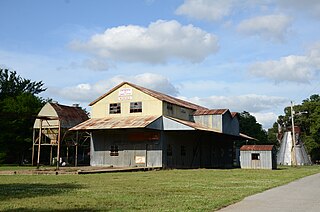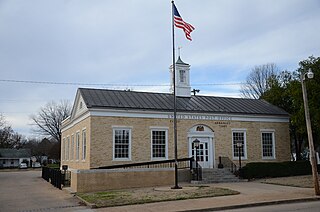
The Jarrell Plantation State Historic Site is a cotton plantation and state park in Juliette, Georgia, United States. Founded as a forced-labor farm worked by the Jarrell family and the black people they enslaved, the site stands today as one of the best-preserved examples of a "middle class" Southern plantation. The Jarrell Plantation's buildings and artifacts all came from the Jarrell family, who farmed the land for over 140 years. Located in the red clay hills of the Georgia piedmont, It was added to the National Register of Historic Places in 1973. It is a Georgia state park in Jones County.

Arkansas Highway 365 is a north–south state highway in Central Arkansas. The route of 69.31 miles (111.54 km) runs from US 65B/US 79B in Pine Bluff north through Little Rock to US 65B/AR 60 in Conway. The route is a redesignation of former U.S. Route 65, which has since been rerouted onto various Interstate highways through the area. Portions of Highway 365 in Jefferson County are former alignments of the Dollarway Road, which was the longest paved concrete road upon completion in 1913.
America is a ghost town in southeastern McCurtain County, Oklahoma, United States. It was located 7 miles southeast of Haworth. The town was named after America Stewart, wife of Tom Stewart, a local resident.

The Simmons - Wright Company is a historic general store established in 1884 in Kewanee, Mississippi, a small town just outside Meridian in Lauderdale County. The building was listed on the National Register of Historic Places in 2008.

Judd Hill is an unincorporated community in Poinsett County, Arkansas, United States. Judd Hill is located on Arkansas Highway 214, 5 miles (8.0 km) south of Trumann. The Judd Hill Cotton Gin, which is listed on the National Register of Historic Places, is located in Judd Hill. Judd Hill was named for banker and businessman Orange Judd Hill, who founded the community.

The Judd Hill Cotton Gin is a historic cotton gin in Judd Hill, Arkansas. The gin was part of the Judd Hill Plantation, which was established by businessman Orange Judd Hill in the 1920s and sold to Hill's daughter and her husband, Esther and Samuel Chapin, in 1933. The cotton gin was built on the plantation circa 1930; its brick construction, designed to prevent fires, makes it a rarity among extant cotton gins. The plantation was successful throughout the 1940s and became one of the largest farms in Poinsett County. The cotton gin ceased operations in the 1970s or 1980s, but the plantation is still operated by the Judd Hill Foundation established by Esther Chapin. On September 28, 2005, the cotton gin was added to the National Register of Historic Places.

The Kemp Cotton Gin Historic District encompasses the only cotton gin extant in the Rohwer area of Desha County, Arkansas. The gin was built in 1950 by O. O. Kemp, a few years after the closure of the Rohwer War Relocation Center, where as many as 10,000 Japanese-Americans were interned during the Second World War. After the center's closure much of its land was returned to agricultural use, and Kemp built this gin near the Missouri Pacific Railroad line that ran through Rohwer. In addition to the gin, the complex Kemp built includes a pump house, scale house, and office. This entire complex was listed on the National Register of Historic Places in 2005.

The Goodlett Gin is a historic cotton gin in Historic Washington State Park in Hempstead County, Arkansas. It was built in 1883 by David Goodlett, and was originally located near Ozan before it was moved to the state park in the late 1970s. It is the only known operational steam gin in the United States. It was fitted with a steam engine in 1898, and received major servicing in the 1930s and 1950s.

The John H. Johnston Cotton Gin Historic District encompasses a historic cotton gin in the small community of Levesque, Arkansas. The main building of the gin was built in 1941, and was built out of reinforced concrete, instead of the more usual steel, owing to a metal shortage in World War II. It has some Moderne styling, with smooth surfaces and rounded corners. The gin also distinctively incorporates a seed storage facility at its rear. Its ancillary structures, which include a shed, privy, and cyclone structure, are wood-framed with metal siding and roofing.

The Wynne Wholesale Commercial Historic District encompasses a small collection of historic commercial properties in Wynne, Arkansas. It extends for two blocks along West Merriman Avenue, west of Martin Luther King Jr. Boulevard, and includes four historic buildings: the Wynne Municipal Water Works, the Wynne Wholesale Grocer Company building, the R. J. Jackson Gin Company's cotton gin, and the Sharp Floral Building. A fifth building, the Wynne Ice & Coal Company's ice house, also stands in the district, but has been recently modified. These building are representative of wholesale business activities that took place in Wynne in the first half of the 20th century.

The Lepanto Commercial Historic District encompasses the traditional commercial heart of the small city of Lepanto, Arkansas. The district includes one block of Greenwood Avenue between Berry and Holmes Streets, and portions of two more blocks at either end, as well as two blocks of Berry Street, with a few buildings on adjacent streets. Lepanto was founded in 1903, but its surviving commercial architecture only dates as far back as c. 1915, when the Portis Company cotton gin was built at the eastern end of the district. Other early buildings include the triangular {{circa|1920} Arlington Light and Power building at 320 Greenwood, and the unusual Barton's of Lepanto building at 111 Berny Street, built as a wood frame lumber yard office {{circa|1920); its walls were bricked in 1955 when it was converted to a hardware store.
The Piggott Commercial Historic District encompasses the original center of the city of Piggott, Arkansas, as originally platted out in 1887. It is centered on the square where the Clay County courthouse is located, buildings facing the courthouse square, and also buildings along some of the adjacent streets. In addition to the courthouse, the district includes the c. 1910 railroad depot, city hall, two churches, the 1930s Post Office building, a cotton gin, and a grain storage yard. The town grew because of the railroad, and the plentiful timber in the area, whose harvesting fueled the early economy in the region. The oldest building in the district is the 1897 Clay County Bank at 188 West Main Street.

The Weldon Gin Company Historic District encompasses a historic cotton gin complex in Weldon, Arkansas. With a history dating to 1833, the Weldon Gin Company was long a staple of the local economy. Located in the center of the town at the junction of Weldon and Washington Streets, the company complex includes a main gin building, built in 1939, and four outbuildings. The present mill was built to replace an earlier steam-powered mill after electricity was introduced to the area in the 1930s.

The Floyd Cotton Gin is a historic cotton gin at the junction of Arkansas Highway 31 and Arkansas Highway 305 in Floyd, Arkansas. It is a two-story wood-frame building roughly L-shaped with a single-story section extending its southern end and a two-story section projecting east under a continuation of the sloping gabled roof. This gin was built in the 1930s, when White County was one of the nation's leading producers of cotton. It is one of five gins in the county to survive from that period.

The Keo Commercial Historic District encompasses a cluster of commercial and industrial buildings that make up the economic center of the small city of Keo, Arkansas. The district includes a two-block section of Main Street, anchored at its southern end by the Cobb Cotton Gin complex, and on the north by Arkansas Highway 232, where it extends a short way in both directions. The community grew around the Cotten Belt Railroad line, which Main Street was laid out just west of. The cotton gin complex has its origins in 1906, as a means for local farmers to process their cotton and send it on to market via the railroad.

The Stipe Cotton Gin is a historic cotton gin at Florida and Cypress Streets in Beebe, Arkansas. It is a two-story steel-framed structure, clad in corrugated metal, that houses the steam compressor and other equipment for processing and baling cotton. The complex also includes a seed storage building, and a circular structure of uncertain function. Built about 1930, it is one of only five to survive in White County from that period, when cotton production was locally at its peak.

The Walker Homestead Historic District encompasses a collection of related agricultural and homesteading properties in rural White County, Arkansas. Located on Gum Spring Road about 1 mile (1.6 km) east of Arkansas Highway 267 southwest of Searcy, the district includes two farmstead houses, a barn, tenant housing, cotton gin, and other features. The oldest portion of the oldest house is a single pen log structure built about 1850 by William Walker, one of the area's early settlers, while the other house is a c. 1900 vernacular Greek Revival structure built by Billy Walker, Sr. The district encapsulates a typical evolutionary history of rural properties in the region, and was listed on the National Register of Historic Places in 1992.

The Paris Post Office is located at 206 North Elm Street in downtown Paris, Arkansas. It is located in a modest Colonial Revival building, built in 1937 as part of a major federal building project. It is notable for the controversy over its interior artwork, which was funded by the Treasury Department's Treasury Section of Fine Arts, and executed by Joseph P. Vorst. The murals proposed by Vorst depicted a raggedly dressed African-American with several skinny mules, approaching a tarpaper shack that appears to be the man's home. There was public outcry, with Vorst defending the depiction as an accurate rendition of the area during a visit he made. He then submitted an alternate drawing, which showed a stock farm, cotton gin, and other more benign imagery, which was accepted.

Frogmore is an historic, privately owned cotton plantation near Ferriday in Concordia Parish, Louisiana. A working farm, it is also a tourist attraction, and may be visited to see old and new cotton farming methods. Buildings on the site include a cotton gin.

The Piazza Cotton Gin is on the Frogmore Plantation at 11656 U.S. Highway 84, about 7 miles (11 km) west of Ferriday, Louisiana in Concordia Parish, Louisiana. The building containing the cotton gin press was built c.1880, while the machinery was added c.1900. The gin itself is a system cotton gin, which was invented by Robert S. Munger. This invention was the second major revolution in cotton processing. This example is one of the few left in existence.



















